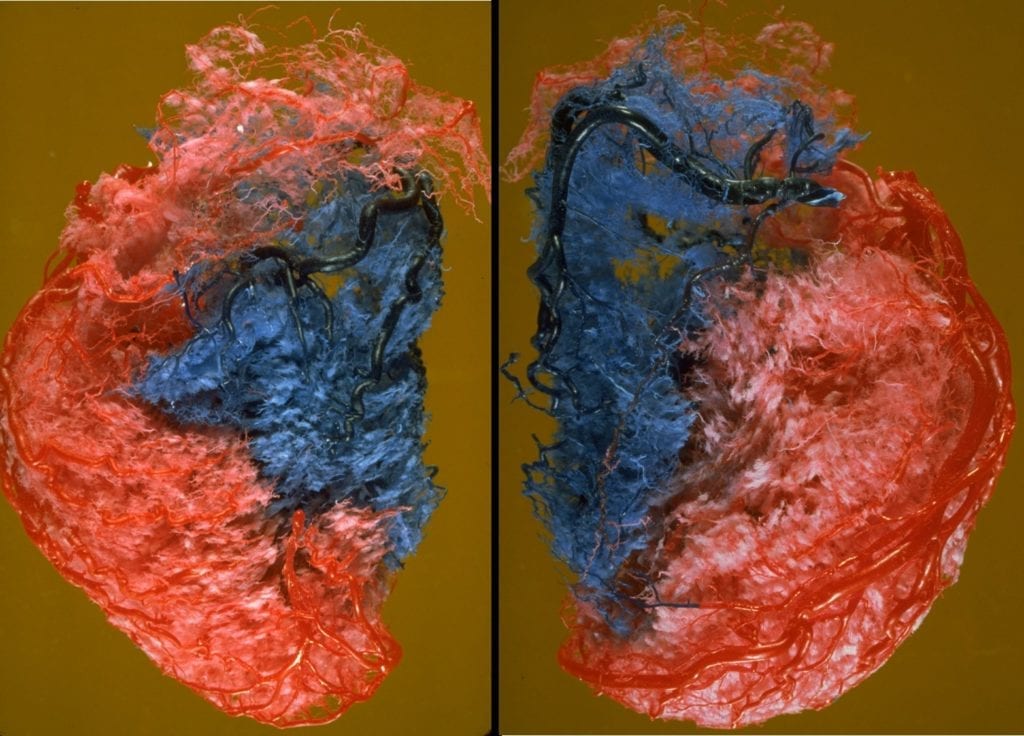Mair Zamir
London, Ontario, Canada

Figure 1. Vasculature of the human heart in an anterior view (right) and posterior view (left). This massive vascular network brings blood to within reach of every cell within the heart tissue. It is the most densely packed vascular network within the body because of the very high metabolic needs of the heart muscle cells which it serves. Yes, the survival of these cells depends on blood, but so much more so it depends on blood FLOW.
We think of blood somewhat reverently as the essence of life. Yet we miss the point. The essence of life is not blood, it is blood flow. When the heart stops beating the body dies, not because of lack of blood but because of lack of blood flow. In most cases the dead body is still awash with blood but this blood is of little use because it is not flowing.
What of life-threatening blood diseases? What of pernicious anemia, sickle-cell disease, thalassemia, leukemia, and hemophilia? Do they not grant blood the power of life and death? Do they not elevate blood to the status of the very essence of life? Yes, but of what relevance or consequence are these diseases if blood is not flowing? Indeed, many blood treatments have little to do with blood and more to do with blood flow, most famously “blood thinners.” Many treatments for “heart disease” rarely have to do with a disease of the heart itself, but rather with a failure of blood flow to reach the heart muscle cells to provide them with the metabolites required for their grueling, incessant work.
What of the nutrients carried by blood that are essential to the survival of every cell within the body? Do they not endow blood with the status of being “the very essence of life”? Once again: Of what use are the vital nutrients carried by blood if blood is not flowing?
Indeed, in what context can we describe blood as being essential to life without including the word “flow” somewhere in that description? Not even the survival of isolated cells in a petri dish full of blood can be said to depend on blood alone without using the word “flow” at some point to explain how that blood is being replenished.
Blood flow is the life-line to every living cell within our body. The driving force that maintains this life-line is of course the pumping action of the heart, but what makes blood able to flow is its fluidity. The fluidity of blood is as essential to life as are the nutrients that blood carries. The scheme which biology has concocted for keeping a complex organism alive is predicated entirely on the fluidity of blood, on the ability of blood to flow. How else would blood be able to reach every one of billions of cells within our body without its ability to flow? (Figure 1)

Figure 2. William Harvey (1578 1657), father of the “circulation.” He was first to put the two words together in blood flow.
Not even in the realm of science fiction can we imagine a living organism of any degree of complexity without the facility of flow in general, and of flow in tubes in particular. To say that flow in tubes is ubiquitous in biology is a gross understatement (Figure 1), which begs the question, teleological perhaps, but compelling nevertheless: Did biology discover the phenomenon of flow in tubes or did it invent it?
There is even more depth to that question. It is a matter of simple mathematics and physics that the flow in a tube is most efficient if the cross section of the tube is circular. More specifically, the flow encounters the least amount of resistance and hence requires the least amount of power to drive it if the cross section of the tube is circular. Not rectangular, nor oval, nor any other shape but circular. Any departure from circular geometry in the form of the cross section of the tube increases the resistance to flow and the power required to drive the flow. The sanctity of this cold fact of mathematics and physics is clearly apparent in the form of the billions of blood vessels within the cardiovascular system. Again we may ask: Did biology discover the magic of the circular cross section for flow in tubes or did it invent it?
The same question applies to fluidity, which is what makes blood flow possible in the first place. Fluidity is one of the most remarkable “almost animate” phenomena in the inanimate world and, like the tube of circular cross section, to say that it is ubiquitous in biology is a gross understatement. Very little would be possible in the evolution or working of organisms, indeed in the evolution or working of our own bodies, without the phenomenon of fluidity, again begging the question: Did biology discover the phenomenon of fluidity and fluid flow, or did it invent it?
Not to deny the pioneering contributions of Herrick,1 Minot,2 Murphy,3 Whipple,4 and Landsteiner,5 it was William Harvey,6 a sixteenth century physician (Figure 2), who first put the two words together in blood flow. His vision of the systemic circulation not only made the two words inseparable but clarified how critical is “flow” in the way blood keeps us alive.
Alas, in the end, to write about blood as distinct from fluidity and fluid flow is to write about medicine as distinct from humanity. The two words are tied together in each case. What is medicine without humanity? What is blood without flow?
Further Reading
- https://en.wikipedia.org/wiki/James_B._Herrick
- https://en.wikipedia.org/wiki/George_Minot
- https://en.wikipedia.org/wiki/William_P._Murphy
- https://en.wikipedia.org/wiki/George_Whipple
- https://en.wikipedia.org/wiki/Karl_Landsteiner
- https://en.wikipedia.org/wiki/William_Harvey
Image Credit
- Resin cast of vasculature of the human heart produced by the author, adapted from: Zamir M, The Physics of Coronary Blood Flow. Springer, New York, 2005.
- Daniël Mijtens – National Portrait Gallery: NPG 5115
MAIR ZAMIR, PhD, is an Emeritus professor at Western University, Canada, specializing in blood flow, the author of 3 books and numerous research publications on the subject, more details here.
Submitted for the 2019–2020 Blood Writing Contest

Leave a Reply